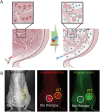Near infrared photoimmunotherapy of cancer; possible clinical applications
- PMID: 36405499
- PMCID: PMC9646249
- DOI: 10.1515/nanoph-2021-0119
Near infrared photoimmunotherapy of cancer; possible clinical applications
Abstract
Near-infrared photoimmunotherapy (NIR-PIT) is a new cancer treatment that uses an antibody-photo-absorber conjugate (APC) composed of a targeting monoclonal antibody conjugated with a photoactivatable phthalocyanine-derivative dye, IRDye700DX (IR700). APCs injected into the body can bind to cancer cells where they are activated by local exposure to NIR light typically delivered by a NIR laser. NIR light alters the APC chemical conformation inducing damage to cancer cell membranes, resulting in necrotic cell death within minutes of light exposure. NIR-PIT selectivity kills cancer cells by immunogenic cell death (ICD) with minimal damage to adjacent normal cells thus, leading to rapid recovery by the patient. Moreover, since NIR-PIT induces ICD only on cancer cells, NIR-PIT initiates and activates antitumor host immunity that could be further enhanced when combined with immune checkpoint inhibition. NIR-PIT induces dramatic changes in the tumor vascularity causing the super-enhanced permeability and retention (SUPR) effect that dramatically enhances nanodrug delivery to the tumor bed. Currently, a worldwide Phase 3 study of NIR-PIT for recurrent or inoperable head and neck cancer patients is underway. In September 2020, the first APC and accompanying laser system were conditionally approved for clinical use in Japan. In this review, we introduce NIR-PIT and the SUPR effect and summarize possible applications of NIR-PIT in a variety of cancers.
Keywords: anti-cancer host immunity; cancer; immunogenic cell death; near-infrared photoimmunotherapy (NIR-PIT); super-enhanced permeability and retention (SUPR) effects.
© 2021 Hiroaki Wakiyama et al., published by De Gruyter, Berlin/Boston.
Figures



Similar articles
-
Near-Infrared Photoimmunotherapy of Cancer.Acc Chem Res. 2019 Aug 20;52(8):2332-2339. doi: 10.1021/acs.accounts.9b00273. Epub 2019 Jul 23. Acc Chem Res. 2019. PMID: 31335117 Free PMC article. Review.
-
Near-Infrared Photoimmunotherapy (NIR-PIT) in Urologic Cancers.Cancers (Basel). 2022 Jun 17;14(12):2996. doi: 10.3390/cancers14122996. Cancers (Basel). 2022. PMID: 35740662 Free PMC article. Review.
-
Near-infrared photoimmunotherapy of cancer: a new approach that kills cancer cells and enhances anti-cancer host immunity.Int Immunol. 2021 Jan 1;33(1):7-15. doi: 10.1093/intimm/dxaa037. Int Immunol. 2021. PMID: 32496557 Free PMC article.
-
Near Infrared Photoimmunotherapy; A Review of Targets for Cancer Therapy.Cancers (Basel). 2021 May 21;13(11):2535. doi: 10.3390/cancers13112535. Cancers (Basel). 2021. PMID: 34064074 Free PMC article. Review.
-
Improved micro-distribution of antibody-photon absorber conjugates after initial near infrared photoimmunotherapy (NIR-PIT).J Control Release. 2016 Jun 28;232:1-8. doi: 10.1016/j.jconrel.2016.04.003. Epub 2016 Apr 5. J Control Release. 2016. PMID: 27059723 Free PMC article.
Cited by
-
Disialoganglioside GD2-Targeted Near-Infrared Photoimmunotherapy (NIR-PIT) in Tumors of Neuroectodermal Origin.Pharmaceutics. 2022 Sep 24;14(10):2037. doi: 10.3390/pharmaceutics14102037. Pharmaceutics. 2022. PMID: 36297471 Free PMC article.
-
Effects of chemotherapy on skeletal muscle mitochondrial oxidative capacity using near-infrared spectroscopy (NIRS): Protocol paper for an observational mixed model repeated measures design in patients with breast and gynecological cancer.PLoS One. 2025 Jun 27;20(6):e0315351. doi: 10.1371/journal.pone.0315351. eCollection 2025. PLoS One. 2025. PMID: 40577323 Free PMC article.
-
Simultaneously Combined Cancer Cell- and CTLA4-Targeted NIR-PIT Causes a Synergistic Treatment Effect in Syngeneic Mouse Models.Mol Cancer Ther. 2021 Nov;20(11):2262-2273. doi: 10.1158/1535-7163.MCT-21-0470. Epub 2021 Sep 13. Mol Cancer Ther. 2021. PMID: 34518299 Free PMC article.
-
Near-infrared photoimmunotherapy in cancer treatment: a bibliometric and visual analysis.Front Pharmacol. 2024 Oct 21;15:1485242. doi: 10.3389/fphar.2024.1485242. eCollection 2024. Front Pharmacol. 2024. PMID: 39498336 Free PMC article.
-
Next-Generation Cancer Treatment: Photoimmunotherapy's Promise for Unresectable Head and Neck Cancers.Pharmaceutics. 2025 May 29;17(6):716. doi: 10.3390/pharmaceutics17060716. Pharmaceutics. 2025. PMID: 40574027 Free PMC article. Review.
References
-
- Cancer WHO. 2018. [Feb. 26, 2021]. https://www.who.int/news-room/fact-sheets/detail/cancer Available at. accessed.
Publication types
Grants and funding
LinkOut - more resources
Full Text Sources
Miscellaneous
